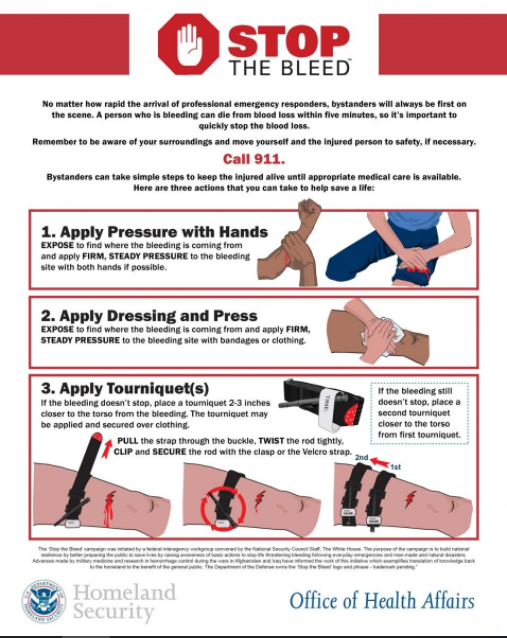It is critical for every person to know how to stop bleeding in an accident victim or other trauma. A trauma victim can bleed to death before EMTs can get to him or her.
Here is how you can learn this life-saving skill – First go through this poster.
After you’ve reviewed the above, watch the Stop The Bleed YouTube videos from the American College of Surgeons:
The Hartford Consensus: How to Use a Tourniquet 2:35
The Hartford Consensus: Improving Survivability 3:39
See Stop the Bleed 3:45
The Cast of ‘Code Black’ on Stop The Bleed 1:07
A Perfect Stranger 2:13
And what follows is from the American College of Surgeons Stop The Bleed site
How to Stop the Bleed
Call 9-1-1
- Call 9-1-1 yourself
OR
- Tell someone to call 9-1-1
Ensure Your Safety
- Before you offer any help, you must ensure your own safety!
- If you become injured, you will not be able to help the victim.
- Provide care to the injured person if the scene is safe for you to do so.
- If, at any time, your safety is threatened, attempt to remove yourself (and the victim if possible) from danger and find a safe location.
- Protect yourself from blood-borne infections by wearing gloves, if available.
Look for Life-Threatening Bleeding
- Find the source of bleeding
- Open or remove the clothing over the wound so you can clearly see it. By removing clothing, you will be able to see injuries that may have been hidden or covered.
- Look for and identify “life-threatening” bleeding. Examples include:
- Blood that is spurting out of the wound.
- Blood that won’t stop coming out of the wound.
- Blood that is pooling on the ground.
- Clothing that is soaked with blood.
- Bandages that are soaked with blood.
- Loss of all or part of an arm or leg.
- Bleeding in a victim who is now confused or unconscious.
Compress and Control
Key Point
There are a number of methods that can be used to stop bleeding and they all have one thing in common—compressing a bleeding blood vessel in order to stop the bleeding.
If you don’t have a trauma first aid kit:
Apply direct pressure on the wound (Cover the wound with a clean cloth and apply pressure by pushing directly on it with both hands)
- Take any clean cloth (for example, a shirt) and cover the wound.
- If the wound is large and deep, try to “stuff” the cloth down into the wound.
- Apply continuous pressure with both hands directly on top of the bleeding wound.
- Push down as hard as you can.
- Hold pressure to stop bleeding. Continue pressure until relieved by medical responders.
If you do have a trauma first aid kit:
For life-threatening bleeding from an arm or leg and a tourniquet is NOT available OR for bleeding from the neck, shoulder or groin:
- Pack (stuff) the wound with a bleeding control (also called a hemostatic) gauze, plain gauze, or a clean cloth and then apply pressure with both hands
- Open the clothing over the bleeding wound. (A)
- Wipe away any pooled blood.
- Pack (stuff) the wound with bleeding control gauze (preferred), plain gauze, or clean cloth. (B)
- Apply steady pressure with both hands directly on top of the bleeding wound. (C)
- Push down as hard as you can.
- Hold pressure to stop bleeding. Continue pressure until relieved by medical responders.
For life-threatening bleeding from an arm or leg and a tourniquet is available:
- Apply the tourniquet
- Wrap the tourniquet around the bleeding arm or leg about 2 to 3 inches above the bleeding site (be sure NOT to place the tourniquet onto a joint—go above the joint if necessary).
- Pull the free end of the tourniquet to make it as tight as possible and secure the free end. (A)
- Twist or wind the windlass until bleeding stops. (B)
- Secure the windlass to keep the tourniquet tight. (C)
- Note the time the tourniquet was applied. (D)
Note: A tourniquet will cause pain but it is necessary to stop life-threatening bleeding.
Instructions and photos have been taken from the Save a Life booklet. Download the booklet for additional information on how to stop the bleed.
Pons PT, Jacobs L. Save a life: What everyone should know to stop bleeding after an injury. Chicago, IL: American College of Surgeons; 2016.
Download the booklet








